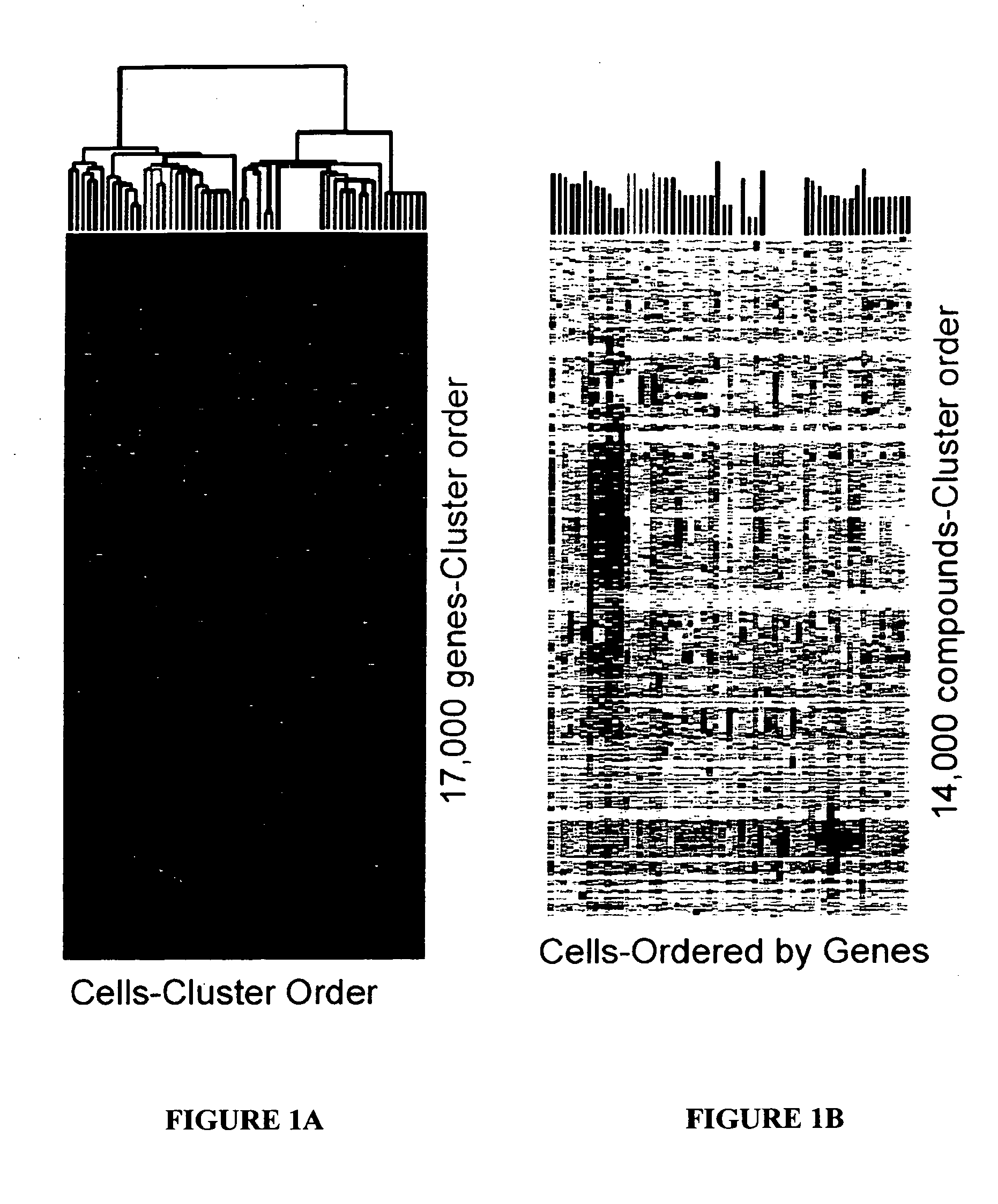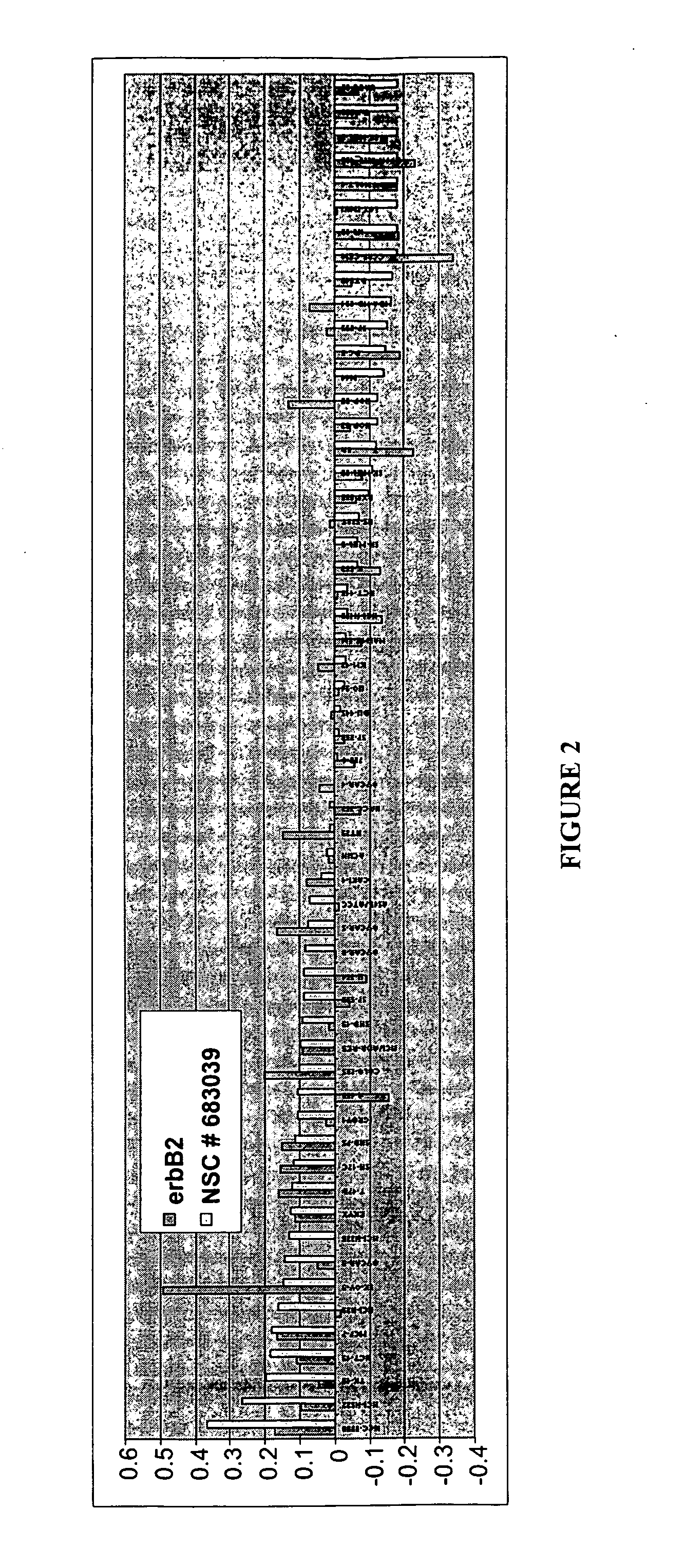Biomarker:compound correlations in cancer diagnosis and therapy
a cancer diagnosis and cancer technology, applied in the field of biomarkers based on compound correlations in cancer diagnosis and therapy, can solve the problems of not being able to detect diagnostic tools, not being able to predict the clinical behavior of breast cancer, and not being able to find effective therapies, so as to effectively inhibit the growth of tumor cells expressing
- Summary
- Abstract
- Description
- Claims
- Application Information
AI Technical Summary
Benefits of technology
Problems solved by technology
Method used
Image
Examples
example 1
Establishing Gene Expression and Drug Sensitivity Patterns Across Tumor Cell Lines
[0108] The present Example describes the inventors' establishment of gene expression pattern profiles containing information on approximately 17,000 unique genes for 59 different tumor cell lines, and also presents compound sensitivity data for approximately 40,000 compounds tested by the National Cancer Institute against the same cell lines.
Materials and Methods
[0109] PRODUCTION OF CDNA MICROARRAYS. The 44,000 human cDNA clones used in these experiments were obtained from Research Genetics (Huntsville, Ala.) as bacterial colonies in 96-well microtiter plates. Each insert was amplified from a bacterial colony by sampling one microliter of bacterial media and performing polymerase chain reaction amplification of the insert using consensus primers for the three plasmids represented in the clone set (5′-TTGTAAAACGACGGCCAGTG-3′, SEQ ID NO:1 and 5′-CACACAGGAAACAGCTATG-3′, SEQ ID NO:2). Each 100 μl PCR p...
example 2
Detecting a Correlation Between a Known Gene and an Interacting Compound
[0118] The present Example establishes the ability of the inventive strategy to establish correlations between genes whose expression varies across tumor cell lines and compounds whose toxicity also varies across tumor cell lines, and whose toxocity is due at least in part to an interaction between the compound and a product of the relevant gene.
[0119] The inventors used normalized gene expression data for the erbB2 gene across the 59 cell lines to identify from a dataset of 14,542 compounds those that had the most highly correlated compound toxicity pattern. The pattern of erbB2 expression was highly correlated with a number of different compounds. The compound showing the strongest correlation, compound number 683039, is a conjugate of an anti-erbB2 antibody (specifically an anti-c-erbB2 disulfide-stabilized Fv fragment) fused to a cytotoxin (specifically a truncated form of Pseudomonas exotoxin). A comparis...
example 3
Detecting a Correlation Between a Known Compound with Known Activity and a Gene Responsible for Resistance to the Compound
[0120] This Example demonstrates, among other things, that the present invention can identify negative correlations between cytotoxic compounds and genes whose products impart resistance to the compounds.
[0121] The present inventors used the pattern of toxicity displayed by Paclitaxol to the NCI60 cell lines to query the gene expression database and identify genes with the most strongly anti-correlated expression patterns. As shown in FIG. 3, the gene with the highest negative correlation was ABCB1, the multidrug resistance p-glycoprotein pump (“PGP”) that is known to impart resistance to Paclitaxol. Furthermore, consistent with the role that PGP plays in removing toxic compounds from cells, the inventors found that PGP expression is significantly negatively correlated with the toxicity patterns of 130 different compounds. An average gene would be expected to s...
PUM
| Property | Measurement | Unit |
|---|---|---|
| volume | aaaaa | aaaaa |
| volume | aaaaa | aaaaa |
| volume | aaaaa | aaaaa |
Abstract
Description
Claims
Application Information
 Login to View More
Login to View More - R&D
- Intellectual Property
- Life Sciences
- Materials
- Tech Scout
- Unparalleled Data Quality
- Higher Quality Content
- 60% Fewer Hallucinations
Browse by: Latest US Patents, China's latest patents, Technical Efficacy Thesaurus, Application Domain, Technology Topic, Popular Technical Reports.
© 2025 PatSnap. All rights reserved.Legal|Privacy policy|Modern Slavery Act Transparency Statement|Sitemap|About US| Contact US: help@patsnap.com



